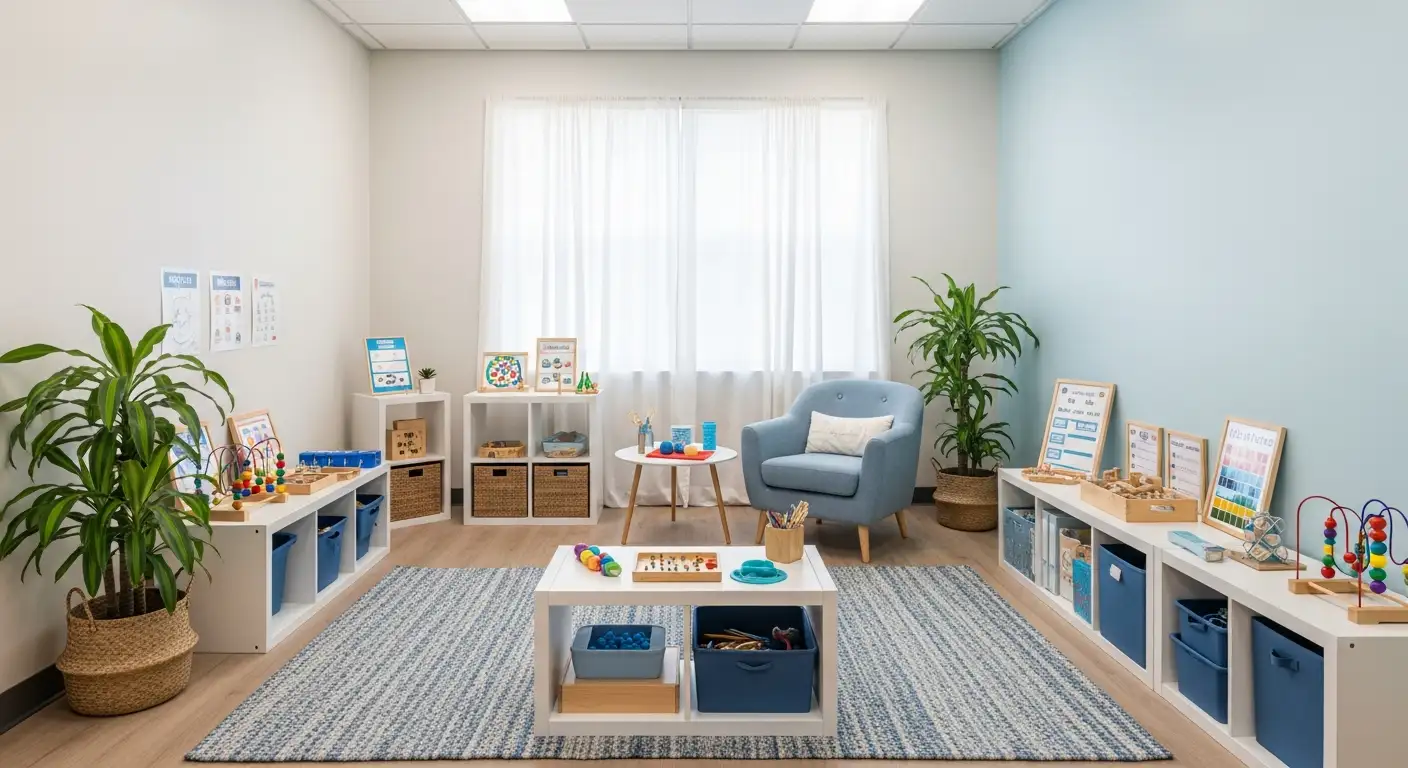Understanding the Foundations of Cooperative Play and Social Development in Autism
Encouraging cooperative work and play among children with autism spectrum disorder (ASD) requires a nuanced understanding of their unique social and communication needs. By implementing practical, evidence-based strategies, caregivers, educators, and family members can facilitate meaningful interactions that nurture friendship, teamwork, and emotional growth. This article explores effective methods, activities, and environmental adjustments designed to promote social engagement and cooperation, drawing from the latest research and best practices.
Using Visual Supports and Structured Routines to Enhance Social Understanding
What practical tips can caregivers and educators use to encourage social skills in children with ASD?
Encouraging social development in children with autism can be effectively supported through simple, structured, and visual strategies. Caregivers and educators are encouraged to use clear and concise language, complemented by visual aids such as social stories, picture cards, and visual schedules. These tools help children understand social expectations, routines, and the sequence of activities, reducing anxiety and promoting engagement.
Modeling positive social behaviors by demonstrating appropriate interactions is crucial. Role-playing social scenarios allows children to practice skills in a safe environment. Repetition and consistency across settings help children generalize these behaviors, leading to greater confidence.
Activities designed to be enjoyable and aligned with the child's interests motivate participation. Whether through games, art, or story-based activities, engaging children in meaningful ways fosters learning and social connection.
Support from a collaborative team—including teachers, therapists, and family members—is essential. Regular communications help tailor approaches based on the child's progress. Reinforcing progress with praise or small rewards motivates children to continue developing their skills.
Additionally, teaching children to recognize and interpret emotions and social cues through visual aids and interactive games helps build empathy and communication abilities. These strategies collectively create a supportive environment where children with ASD can thrive socially.
How can environments be made autism-friendly to foster cooperation and play?
Creating autism-friendly environments requires thoughtful adjustments to reduce sensory overload and promote positive interactions. Incorporating sensory-friendly spaces such as quiet zones, where children can retreat when overwhelmed, helps regulate sensory inputs. Using sensory tools like textured toys, weighted blankets, and noise-canceling headphones can further support sensory needs.
Establishing predictable routines with visual supports, including charts, signs, and transition cues, can ease transitions and set clear expectations. Consistent schedules provide structure that reassures children and decreases behavioral difficulties.
Designing inclusive settings involves promoting peer interactions through organized play and shared activities. Peer modeling and social stories help children understand social norms, encouraging cooperative play.
Environmental design elements like calming color schemes, soft lighting, and designated sensory areas contribute to a comfortable atmosphere. Offering choices within activities and maintaining a degree of flexibility allows children to engage at their own pace.
Implementing adaptive communication supports, such as augmentative and alternative communication (AAC) devices, ensures that children can express their needs and participate actively.
Overall, cultivating an environment that is predictable, sensory-friendly, and inclusive helps children with autism feel secure, encouraging cooperation, play, and social development.
Implementing Routine and Consistency to Foster Social Skill Development

What techniques support social interaction and communication development in children with ASD?
Children with autism benefit greatly from structured and visual supports that clarify social expectations. Visual aids such as picture cards, social stories, and video modeling help these children understand social cues, routines, and expected behaviors. These supports make abstract social concepts more concrete and accessible.
Role-playing, practicing social narratives, and demonstrating positive behaviors through modeling provide valuable opportunities for children to learn and imitate social skills in both structured and everyday settings. Participating in group activities supervised by trained professionals, including play therapy and turn-taking games, also enhances social interaction skills.
Reinforcement strategies are essential for encouraging continued effort. Consistent routines, positive praise, and collaboration with caregivers support the child’s motivation and help these skills transfer across environments. Combining visual tools, direct instruction, peer supports, and tailored strategies creates a comprehensive approach that nurtures meaningful social development for children with ASD.
What strategies can be employed to support cooperative behavior in children with ASD?
Supportive strategies focus on clear, simple communication paired with visual aids. Visual supports like picture checklists, social stories, and schedules improve understanding of social tasks and expectations.
Establishing predictable routines using visual schedules reduces uncertainty and anxiety, making cooperation more likely. Breaking complex tasks into small, manageable steps also helps children stay engaged without becoming overwhelmed.
Positive reinforcement is crucial. Praising children with specific descriptions of their good behaviors, offering tangible rewards like stickers or high-fives, and celebrating milestones encourage ongoing cooperation.
Structured social skills training, role-playing, and peer interaction opportunities help children practice social behaviors in safe, controlled settings. Organizing social activities such as playdates or group games further promotes natural social exchanges, reinforcing cooperative behavior.
Use of visual schedules, checklists, and transition cues
Visual schedules and checklists serve as clear guides for children, outlining daily routines and tasks. Transition cues, like visual timers or signaling words, prepare children for upcoming changes, helping minimize stress and resistance.
These tools create predictability, which is particularly important for children with autism who often thrive on routine. Regular use across different environments ensures familiarity and comfort.
Establishing consistent routines to reduce anxiety
Consistency in routines, reinforced through visual supports, establishes a secure environment. When children know what to expect, they feel more confident, which encourages participation and positive social interactions.
Repetition of routines reinforces learning and habits, making social skills more natural and spontaneous over time.
Repetition and reinforcement for skill generalization
Repeatedly practicing social behaviors in varied settings cements these skills. Reinforcement through praise or rewards motivates children to apply learned behaviors consistently.
With ongoing repetition and positive feedback, children start to internalize social norms, leading to improved cooperation and social competence.
| Strategy | Description | Example |
|---|---|---|
| Visual Supports | Use of pictorial aids to clarify routines, rules, and social cues | Visual schedule for daily activities |
| Consistent Routines | Repeating familiar routines to foster predictability | Morning routine poster with pictures |
| Breaking Tasks into Steps | Dividing activities into manageable parts | Putting on coat in steps: zip, button, etc. |
| Positive Reinforcement | Rewarding desired behaviors to promote repetition | Giving a high five after sharing a toy |
| Structured Activities and Play | Organized social activities to practice social skills | Turn-taking games and role-playing exercises |
| Repetition and Practice | Regularly practicing skills in different settings | Reinforcing greeting routines at home and school |
Implementing these routines and supports creates a stable environment that fosters trust and security. As children become familiar with expectations, they develop greater independence and social skills, paving the way for more meaningful peer interactions and cooperative behavior.
Activities That Promote Turn-Taking, Sharing, and Cooperative Play

What activities and routines facilitate cooperative play among children with ASD?
Cooperative play in children with autism spectrum disorder (ASD) is supported through carefully designed activities that emphasize sharing, turn-taking, and social interaction.
Structured, goal-oriented tasks such as building with blocks or creating collaborative drawings are highly effective. These activities encourage children to focus on a common objective, fostering teamwork and patience.
Using visual supports like social stories, charts, and cue cards helps children understand what behaviors are expected during play. Visual schedules and step-by-step instructions make routines predictable, reducing anxiety and promoting cooperation.
Starting with play types like parallel and associative play allows children to build confidence and social awareness step by step. Role-playing scenarios and social stories clarify social norms, helping children recognize social cues and boundaries.
Involving peer modeling—where typically developing children demonstrate appropriate social behaviors—guides children with ASD to imitate and learn social skills.
Reinforcements such as praise, high fives, and small rewards motivate children to participate actively. Sensory-friendly adjustments, like noise-canceling headphones or sensory breaks, help children stay comfortable and engaged.
Overall, combining these activities within a routine that emphasizes predictability and support creates a solid foundation for developing cooperative play skills.
What techniques support social interaction and communication development in children with ASD?
Enhancing social interaction and communication involves a mix of visual, behavioral, and social strategies. Visual supports—such as picture cards, social stories, and video modeling—are fundamental tools. These help children grasp social cues, rules, and expectations more clearly.
Structured activities like social skills groups, play therapy, and turn-taking games serve as safe environments for practicing interactions. Children learn from observing peers, which fosters imitation and understanding.
Direct modeling by adults and peers demonstrates appropriate behaviors like sharing, asking questions, and waiting for turns. Role-playing and storytelling further reinforce these concepts.
Consistency is vital; routines that incorporate these strategies ensure skills are reinforced and generalized outside therapy settings. Positive reinforcement, including praise and tangible rewards, encourages children to engage and persist.
By integrating visual aids, structured play, peer involvement, and individualized interventions, children with ASD can develop meaningful social and communication skills.
| Activity/Technique | Purpose | Implementation Examples | Additional Notes |
|---|---|---|---|
| Visual supports (pictures, stories) | Aid understanding of social cues | PECS, social stories, video modeling | Enhance comprehension and recall |
| Structured social groups | Practice social skills in a controlled environment | Facilitated by trained professionals | Build confidence and social competence |
| Peer modeling | Demonstrate appropriate social behaviors | Typical peers engaging in joint activities | Promotes imitation and natural learning |
| Role-playing and storytelling | Practice social norms and responses | Children act out scenarios, using visual aids | Improves empathy and reciprocity |
| Reinforcement (praise, rewards) | Motivate engagement and good behavior | High fives, stickers, verbal praise | Reinforces learned behaviors and increases motivation |
How do these activities support the transition from parallel to cooperative play?
Beginning with parallel play—where children play side-by-side without direct interaction—is a natural first step for many children with ASD. Activities such as building a puzzle together or drawing in shared spaces encourage children to engage in a shared focus.
Gradually, supported by visual cues and role-playing, children can move to associative play, involving simple interactions like exchanging toys or making comments during play.
Introducing turn-taking games, like sharing a ball or playing simple board games, teaches patience and cooperation. Modelings of polite social interactions and prompts help children understand the give-and-take nature of cooperation.
As children become comfortable with these routines, they are increasingly able to participate in cooperative activities—working together towards common goals, sharing resources, and engaging in joint problem-solving.
Creating an environment rich in clear expectations, positive reinforcement, and sensory accommodations ensures each stage of play development is supported at the child's pace.
| Transition Stage | Description | Activities and Supports | Expected Outcomes |
|---|---|---|---|
| Parallel play | Playing side-by-side without interaction | Building with blocks, drawing near each other | Comfort in shared space, basic social awareness |
| Associative play | Simple sharing and interactions | Exchanging toys, cooperative drawing | Foundation for interaction, understanding social cues |
| Cooperative play | Working together with shared goals | Turn-taking games, group storytelling | Development of negotiation, empathy, teamwork |
Final notes
These activities and strategies, used thoughtfully and consistently, build a child's social confidence and cooperation skills. They help children with autism transition smoothly through different stages of play, ultimately fostering a more inclusive, engaging, and supportive environment.
Supporting Peer Interaction through Play and Group Activities
How do you encourage an autistic child to play and interact with others?
Encouraging children with autism to engage in play and social interactions involves creating structured and enjoyable opportunities that foster their social skills. Incorporating visual aids, such as picture schedules or social stories, helps clarify expectations and routines, making social scenarios less stressful and more understandable.
Building opportunities for interaction gradually is essential. Starting with parallel play, where the child plays alongside peers without direct interaction, sets the foundation. As confidence grows, guided or supported playdates can introduce turn-taking, sharing, and cooperation.
Modeling positive social behaviors by demonstrating how to ask for toys, share, or take turns teaches children what to do. Pairing this with praise and small rewards—like a high five or verbal encouragement—motivates children to participate.
Incorporating the child's interests into play encourages motivation. For instance, if a child loves trains, organizing a train-themed group activity can spark engagement and peer interaction.
Supporting emotional self-regulation also plays a role. Using sensory tools if needed, and teaching calming techniques, helps children manage stress and feel secure enough to engage with others.
Overall, consistency, patience, and adapting activities to the child's developmental level enhance their confidence and foster meaningful peer connections.
What are effective ways to teach sharing and cooperation to children with ASD?
Teaching sharing and cooperation requires an intentional approach that combines visual supports, social cues, and reinforcing positive behaviors. Visual aids like picture cards depicting sharing or turn-taking help children understand social rules visually, reducing ambiguity.
Using social stories provides children with clear, positive explanations of social expectations. For example, stories that show scenarios of sharing toys or helping a peer promote understanding and acceptance.
Demonstrating appropriate behaviors through modeling—either by therapists, parents, or peers—gives children visible examples to imitate. Structured activities, such as turn-taking games, are practical for practicing these skills.
Reinforcement is crucial; praise or small rewards for sharing or cooperating encourage repetition. Repeated practice in social groups or during play supports behavior generalization.
Professional interventions like Applied Behavior Analysis (ABA) tailor strategies to each child's needs, emphasizing consistency and clear goals.
Ultimately, patience and positive experiences, supported by a predictable environment, help children with ASD develop successful sharing and cooperation skills.
| Strategy | Method | Purpose | Examples | |---|---|---|---| | Visual supports | Picture cards, schedules | Clarify social rules | Sharing, turn-taking prompts | | Social stories | Illustrated narratives | Teach social expectations |
Promoting Play and Social Interaction through Therapies and Interventions
What play therapies are effective for children with autism?
Play therapy is a valuable approach for children with autism, helping them engage in activities they enjoy and fostering self-expression. It also assists in modifying challenging behaviors into safe and constructive expressions through toys or activities of their choice.
The primary goal of play therapy is to address psychosocial difficulties and support overall healthy development. To be effective, therapy must be tailored to each child's unique needs, which requires proper evaluation at the outset.
Various types of play therapy can be used for children with autism, including:
| Type of Play Therapy | Description | Purpose |
|---|---|---|
| Child-centered | This approach lets children guide the play, encouraging them to explore at their own pace | Promotes self-expression and emotional regulation |
| Floor time | Engages children through play activities on the floor, emphasizing social engagement | Builds social interaction, communication |
| Art-based | Uses drawing, painting, or sculpting to facilitate emotional expression | Supports emotional growth and sensory integration |
| Equine-assisted | Involves interaction with horses to foster trust and social skills | Develops emotional regulation and motivation |
Research indicates that play influences brain development, affecting areas responsible for neural connectivity and neuroplasticity. Combining play therapy with sensory integration techniques can significantly enhance emotional well-being, developmental progress, and social growth.
Play therapy provides a safe environment where children learn to control their emotions, develop social abilities, and communicate more effectively. The success of these interventions depends on various factors including the child's age, severity of ASD, family involvement, and therapist competency.
How do you encourage an autistic child to play and interact with others?
Fostering social interaction in children with autism requires creating structured, engaging, and supportive environments. Visual supports, such as cues, social stories, and clear rules, help children understand social expectations, promoting participation in both parallel and cooperative play.
Modeling social behaviors by demonstrating interactions during activities, combined with positive reinforcement like praise or rewards, encourages children to engage more socially. Introducing peer interactions gradually through carefully organized playdates or group activities helps children practice sharing, turn-taking, and communication.
Integrating the child's interests and strengths into play increases their motivation. For example, if a child enjoys drawing or building, incorporating these into play sessions can promote social engagement.
Teaching empathy and perspective-taking through activities and role-playing enhances their understanding of others' feelings. Maintaining routines and providing tools, such as sensory regulation items, help children feel safe and comfortable in social contexts.
By combining visual supports, modeling, positive reinforcement, and routine, caregivers and therapists can effectively support children with autism in developing meaningful social and play skills. This comprehensive approach nurtures friendships, improves communication, and boosts confidence, paving the way for better social integration.
Collaborative Interventions for Enhancing Social and Play Skills

What evidence-based approaches are effective in enhancing social cooperation and play skills in children with ASD?
Research shows that multiple approaches are effective in boosting social and play abilities among children with autism spectrum disorder (ASD). Among these, video modeling stands out with an average Percentage of Non-overlap of Data (PND) of 84.25%, highlighting its high effectiveness.
Other successful strategies include social stories, which visually depict social situations and expected behaviors, and peer-mediated interventions, where typically developing children support social interactions.
Additional practices supported by evidence are Picture Exchange Communication System (PECS), Pivotal Response Training (PRT), naturalistic language strategies, and social narratives. These methods help children understand social cues and participate more actively.
Tools like social skills training (SST), functional communication training (FCT), imitation and modeling techniques, and voice output communication aids (VOCA) also foster social cooperation and play skills.
It remains essential for therapists and educators to regularly assess the impact of these interventions, ensuring programs are implemented with fidelity to maximize benefits. Tailoring strategies to meet individual child needs can greatly enhance their social and playful engagements.
The Role of Play Therapy and Sensory Integration in Social Development

How does play therapy influence neural connections and emotional control in children with autism?
Play therapy plays a crucial role in supporting brain development for children with autism. It influences specific areas involved in social and emotional processing, helping to strengthen neural networks responsible for communication, emotional regulation, and social interaction.
Research shows that engaging in play activities can enhance neuroplasticity, allowing the brain to form new connections and pathways. When children participate in structured play, especially combined with sensory integration techniques, they often demonstrate improved brain function. This supports better self-regulation, emotional control, and social understanding.
For example, during therapeutic play, children learn to recognize and express their feelings more effectively. Over time, this can lead to reduced anxiety and better emotional resilience. Play-based interventions also promote connectivity between different brain regions, which is essential for coordinated behavior and adaptive responses.
By actively involving children in meaningful play, therapists help forge stronger neural links that underpin emotional stability and social competence, encouraging healthier development trajectories.
How do sensory-friendly environments and sensorimotor activities support social growth?
Creating sensory-friendly spaces is essential for children with autism to engage comfortably in social activities. These environments are designed to minimize overstimulation from loud noises, bright lights, and unpredictable sensory inputs, making children feel secure.
In such settings, sensorimotor activities—like swinging, textured play, or weighted blankets—serve as calming tools. They help children regulate their sensory experiences, reducing stress and sensory overload that can interfere with social engagement.
Activities integrated into sensory-friendly environments include using tactile toys, calming visual aids like soft lighting and visual schedules, and offering quiet zones for rest. These measures promote a sense of safety and control, allowing children to participate more confidently in social interactions.
Furthermore, sensory play can enhance focus, attention, and emotional regulation, forming a foundation for building social skills. For example, when children feel less overwhelmed, they are more receptive to engaging with peers and adults, fostering peer relationships and cooperative play.
What therapies are effective for children with autism?
Play therapy helps children with autism to engage in activities of their interest and choice, facilitating self-expression and modifying unwanted behaviors into non-injurious expressive behaviors using toys or activities of their choice. Play therapy aims to prevent or solve psychosocial difficulties and support healthy child development, with adaptation to each child's unique needs. Proper evaluation of the child is mandatory to determine the most suitable type of play therapy. Different types of play therapy can be used for children with autism, including child-centered, child-led, floor time, equine-assisted, art-play, and others; the choice depends on the child's needs and response.
Play influences brain development by affecting brain areas, structures, and functions, improving neural connectivity and neuroplasticity. Play therapy, especially when combined with sensory integration, supports emotional well-being, functional development, and typical growth in children with ASD. Play therapy provides a safe environment for children with autism to learn self-regulation, improve social skills, and express emotions, which can lead to improvements in social interaction and communication.
The efficacy of play therapy varies among children with autism, depending on factors such as age at initiation, severity, family involvement, therapist competency, and type of therapy.
How can you encourage an autistic child to play and connect with others?
Encouraging social play in children with autism requires creating supportive, structured, and engaging environments. Using visual supports like picture cards, social stories, and clear rules helps children understand what is expected during play, making social interactions less confusing.
Organized playdates and small group activities are effective in gradually developing social skills. Starting with parallel play, where children play side-by-side, and progressing to shared play, helps children build confidence.
Modeling behaviors by demonstrating toy use, turn-taking, or sharing encourages children to imitate social interactions. Providing positive reinforcement through praise or small rewards encourages participation and effort.
Incorporating the child's interests into play boosts motivation. For example, if a child loves trains, using train sets to practice turn-taking and teamwork can be effective.
Supporting emotional self-regulation with sensory tools like noise-canceling headphones or sensory breaks helps children manage overstimulation. This readiness supports social interaction and deepens peer connections.
Overall, structured, engaging, and interest-based approaches combined with patience and positive reinforcement help children with autism learn and enjoy social play.
| Strategy | Description | Benefit |
|---|---|---|
| Visual supports | Picture cards, stories, and schedules | Clarifies expectations, reduces anxiety |
| Peer modeling | Demonstrating social behaviors through peers | Encourages imitation, social learning |
| Organized playdates | Supervised grouping of children for structured play | Builds social skills gradually |
| Reinforcement | Praise, rewards for positive behavior | Motivates participation |
| Sensory tools | Headphones, textured toys, calming environments | Supports emotional regulation, focus |
Creating opportunities for collaborative, structured play, supported by visual and sensory tools, can significantly enhance social skills development in children with autism.
Combining Therapeutic Approaches to Maximize Social and Play Skills

What evidence-based approaches are effective in enhancing social cooperation and play skills in children with ASD?
Effective strategies backed by research to improve social cooperation and play in children with autism spectrum disorder (ASD) include a variety of well-supported techniques. Video modeling stands out with an average Percentage of Non-overlapping Data (PND) of 84.25%, making it highly effective in teaching social behaviors. This method involves demonstrating desired social interactions through videos, which children can imitate.
Other proven approaches encompass social stories, which use visual narratives to teach social norms and responses; peer-mediated interventions, where typically developing children support social engagement; Picture Exchange Communication System (PECS), which promotes functional communication; Pivotal Response Training (PRT), focusing on motivation and responsivity; naturalistic language strategies that embed teaching into everyday activities; and social narratives tailored to individual needs. Additional practices include social skills training (SST), functional communication training (FCT), imitation and modeling exercises, and voice output communication aids (VOCA).
Continuous monitoring of intervention outcomes, fidelity in implementation, and customization to each child's unique profile are essential. Collaboration between therapists, educators, and families ensures optimal application of these techniques, resulting in meaningful improvement in social and play domains.
Fostering Lasting Social Skills and Cooperative Play
Creating an environment that supports social cooperation, structured routines, and tailored interventions can significantly enhance the social and play skills of children with ASD. Through collaborative efforts among parents, educators, therapists, and peers, children learn to navigate social norms, build friendships, and develop empathy. Incorporating visual supports, therapeutic activities, and sensory-friendly environments ensures engagement and emotional safety. By gradually increasing opportunities for peer interaction and providing consistent reinforcement, caregivers can help children with autism reach their full social potential. This ongoing process of tailored, comprehensive support fosters not only better social skills but also a richer, more inclusive childhood experience for children with ASD and their peers.
References
- Increasing Cooperation in Kids With Autism - Child Mind Institute
- Playing with others: autistic children - Raising Children Network
- The Art of Autism: 8 Collaborative Strategies for Success
- Developing Cooperative Play Skills For Children With Autism In ...
- Promoting Peer Engagement for Young Children on the Autism ...
- Play therapy in children with autism: Its role, implications, and ...
- Best Ways to Create a Autism-Friendly Environment for a Child
- Teaching Social Skills to Children with Autism - - Special Learning









